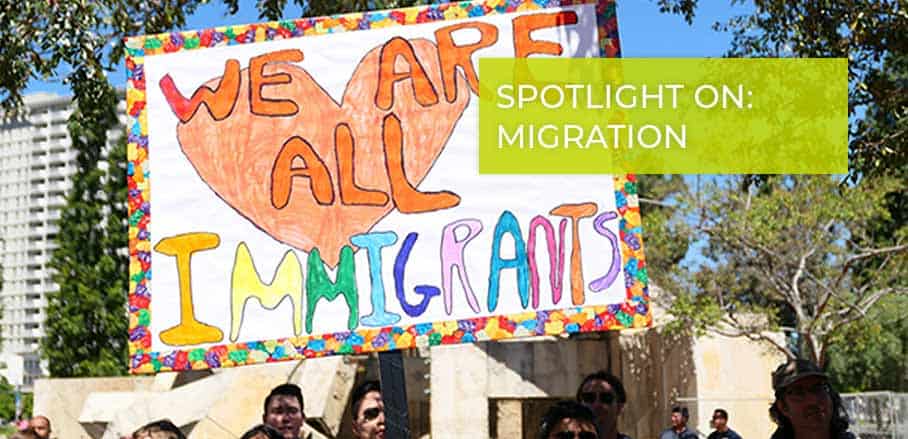Migration: An Essential Pillar of Human Civilisation
Migration has always been a catalyst of knowledge, of culture, of science – an aspect that often goes unmentioned in the recent, heated debates on migration. On the occasion of the Global Compact for Migration, Christopher Dekki outlines how important migration is to urban areas, while at the same time emphasising the role cities and communities have to play in these dynamics.
Migration has been essential to the development of human civilisation. It was the movement of people that underpinned the critical cultural, scientific, and knowledge exchanges at the heart of human history. Moreover, migration has allowed for the flourishing of cities: it is a central pillar of urbanisation, which ultimately established the type of human settlements which solidified our ancestors’ place as the apex species on Earth.
Certainly, migration is an act not unique to human beings. Birds migrate in search of friendlier climes, fish migrate in search of food. Nevertheless, the complexity of the human person, the multidimensional nature of our existence, and our understanding of our place in the world mean that the reasons why people move from one place to another rises above the movements of flocks of birds or schools of fish.
It was this multifaceted reality of the human person that helped fuel migration, whether to satisfy basic needs or to achieve certain wants, whether in search of greater glory or peace – it was this very act of movement that truly facilitated our social, political, and economic evolution.
Current Trends
Despite all this, migration in contemporary times has been framed a “problem” on which governments must act, an “issue” that needs to be solved. Echoes of the recent past, when nativists in places like the United States blamed social, economic, and political ills on immigrants leaving their home countries, are once again being heard.
Such nativists turn against entire groups of people that are forced to migrate: Rohingya, Syrians, Iraqis, Hondurans, West Africans, and many more. They are often reduced to their desperation and desire for security elsewhere. At the same time, voices of hatred and prejudice directed against them can be heard clearly and distinctly.
Whatever the case, whatever lies at the heart of these movements of migrants, whatever their reasons, hopes, or dreams, it is critical that mankind recalibrates its general views regarding migrants and that it rediscovers the creative energy of migratory activity.
Without the interaction, sharing, and mixing of the past millennia, the world and the place that human beings occupy in it would be radically different. The revolutionary progress humanity has made century after century, era after era, epoch after epoch, has been catalysed by the migration of ideas, of technological advancements, of science, language, and literature, and of course, people.
The Urban Phenomenon
Urban growth and migration go hand in hand, and as the world comes to terms with the movement of people today, it is cities that have the most central role to play in welcoming, resettling, and integrating migrants.
For all the rancour by some on a national level, it is in fact local communities that must ultimately work with migrants at the most human level. Therefore, it is cities and towns that can harness migrant energy for their own sustainable development, as well as the sustainable development of regions and countries.
The Global Compact for Migration
With the finalisation and imminent adoption of the United Nation’s Global Compact for Safe, Orderly and Regular Migration, attention is finally being paid at the highest political levels to the important issues facing migrants and the communities to which they migrate. Energy, resources, and political will help to ease the pressing problems facing migrants, as well as assist the people and places welcoming them.
Throughout the compact, UN member states promise to work directly with local and subnational authorities to help to manage migration meaningfully, as well as to replicate the many successes that local governments have had in dealing with the resettlement and normalisation of migrants.
Together, national and subnational governments can help improve the situation of migrants, as well as build the trust necessary to support civic engagement and improve sustainable development. The Global Compact for Migration can help restore an understanding of the historical benefits of migration. It presents a path forward to meaningfully include a vulnerable and often marginalised group in the implementation of global development commitments, from the 2030 Agenda for Sustainable Development to the New Urban Agenda.
New Threats
But there are new dangers to the efforts of the international community, as well as threats to the cities and towns who are setting examples in how to best treat, integrate, and value migrants. In far too many countries, old, divisive political ideologies are resurfacing, gaining ground, attracting followers, and, most worryingly, forming governments.
Even average voters, regular citizens with little hate and no inclination towards prejudice, have been desperately searching for alternatives to an economic and political status quo that has spurred excessive inequalities. This dynamic has been leading far too many citizens in countries throughout the world to embrace far-right, anti-migrant ideologues.
As the adoption of the Global Compact for Migration draws near, the success of the intergovernmental process could be derailed by the growing challenges presented by increasing nationalism. More than ever, cities must rise to the challenge and continue to set the tone for how migrants can become participants in the sustainable development of the communities in which they settle. History has proven that migration is an essential feature of the growth and development of human civilisation. The time has come to remind the world of this important fact.
